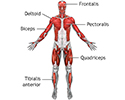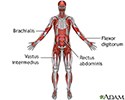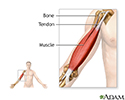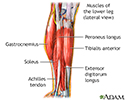Myotonia congenita
Thomsen's disease; Becker's disease
Myotonia congenita is an inherited condition that affects muscle relaxation. It is congenital, meaning that it is present from birth. It occurs more frequently in northern Scandinavia.
Causes
Myotonia congenita is caused by a genetic change (mutation). It is passed down from either one or both parents to their children (inherited).
Myotonia congenita is caused by a problem in the part of the muscle cells that are needed for muscles to relax. Abnormal repeated electrical signals occur in the muscles, causing a stiffness called myotonia.
Symptoms
The hallmark of this condition is myotonia. This means the muscles are unable to quickly relax after contracting. For example, after a handshake, the person is only very slowly able to open and pull away their hand.
Early symptoms may include:
- Difficulty swallowing
- Gagging
- Stiff movements that improve when they are repeated
- Shortness of breath or tightening of the chest at the beginning of exercise
- Frequent falls
- Difficulty opening eyes after forcing them closed or crying
Children with myotonia congenita often look muscular and well-developed. They may not have symptoms of myotonia congenita until age 2 or 3.
Exams and Tests
The health care provider may ask if there is a family history of myotonia congenita.
Tests include:
- Electromyography (EMG, a test of the electrical activity of the muscles) and nerve conduction studies (NCS)
- Genetic testing
- Muscle biopsy
Treatment
Mexiletine is a medicine that treats symptoms of myotonia congenita. Other treatments include:
- Phenytoin
- Procainamide
- Quinine (rarely used now, due to side effects)
- Tocainide
- Carbamazepine
Support Groups
The following resources can provide more information on myotonia congenita:
- Muscular Dystrophy Association -- www.mda.org/disease/myotonia-congenita
- National Library of Medicine, Medline Plus -- medlineplus.gov/genetics/condition/myotonia-congenita/
Outlook (Prognosis)
People with this condition can do well. Symptoms only occur when a movement is first started. After a few repetitions, the muscle relaxes and the movement becomes normal.
Some people experience the opposite effect (paradoxical myotonia) and get worse with movement. Their symptoms may improve later in life.
Possible Complications
Complications may include:
- Aspiration pneumonia caused by swallowing difficulties
- Frequent choking, gagging, or trouble swallowing in an infant
- Long-term (chronic) joint problems
- Weakness of the abdominal muscles
When to Contact a Medical Professional
Contact your provider if your child has symptoms of myotonia congenita.
Prevention
Couples who want to have children and who have a family history of myotonia congenita should consider genetic counseling.
References
Bharucha-Goebel DX. Muscular dystrophies. In: Kliegman RM, St. Geme JW, Blum NJ, Shah SS, Tasker RC, Wilson KM, eds. Nelson Textbook of Pediatrics. 21st ed. Philadelphia, PA: Elsevier; 2020:chap 627.
Kang MK, Kerchner GA, Ptácek LJ. Channelopathies: episodic and electrical disorders of the nervous system. In: Jankovic J, Mazziotta JC, Pomeroy SL, Newman NJ, eds. Bradley and Daroff’s Neurology in Clinical Practice. 8th ed. Philadelphia, PA: Elsevier; 2022:chap 98.
Selcen D. Muscle diseases. In: Goldman L, Schafer AI, eds. Goldman-Cecil Medicine. 26th ed. Philadelphia, PA: Elsevier; 2020:chap 393.
Superficial anterior muscles - illustration
Superficial anterior muscles
illustration
Deep anterior muscles - illustration
Deep anterior muscles
illustration
Tendons and muscles - illustration
Tendons and muscles
illustration
Lower leg muscles - illustration
Lower leg muscles
illustration
Review Date: 1/23/2022
Reviewed By: Joseph V. Campellone, MD, Department of Neurology, Cooper Medical School at Rowan University, Camden, NJ. Review provided by VeriMed Healthcare Network. Also reviewed by David Zieve, MD, MHA, Medical Director, Brenda Conaway, Editorial Director, and the A.D.A.M. Editorial team.








